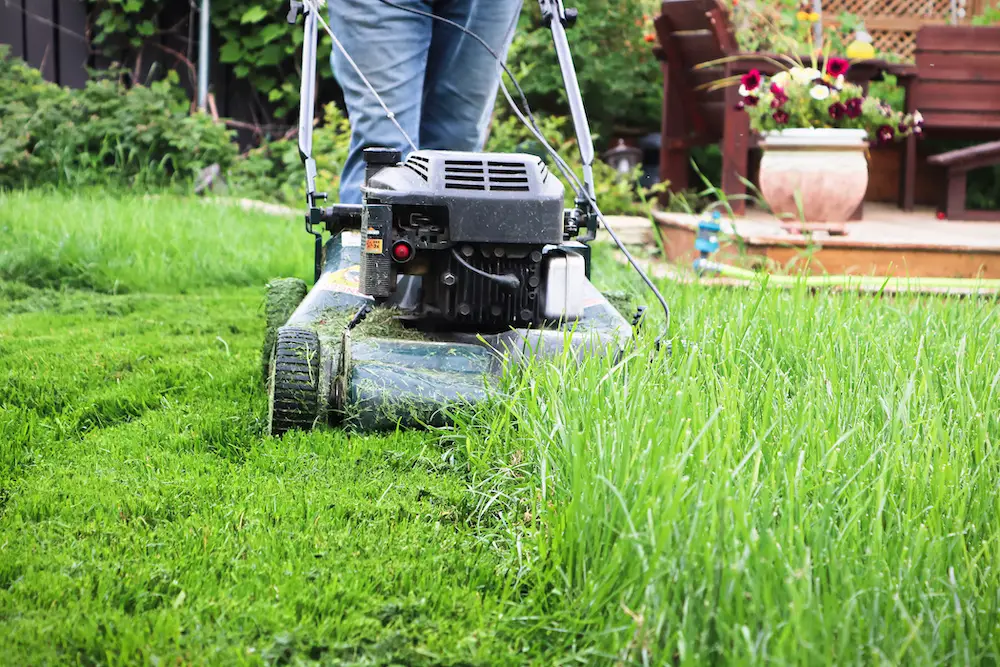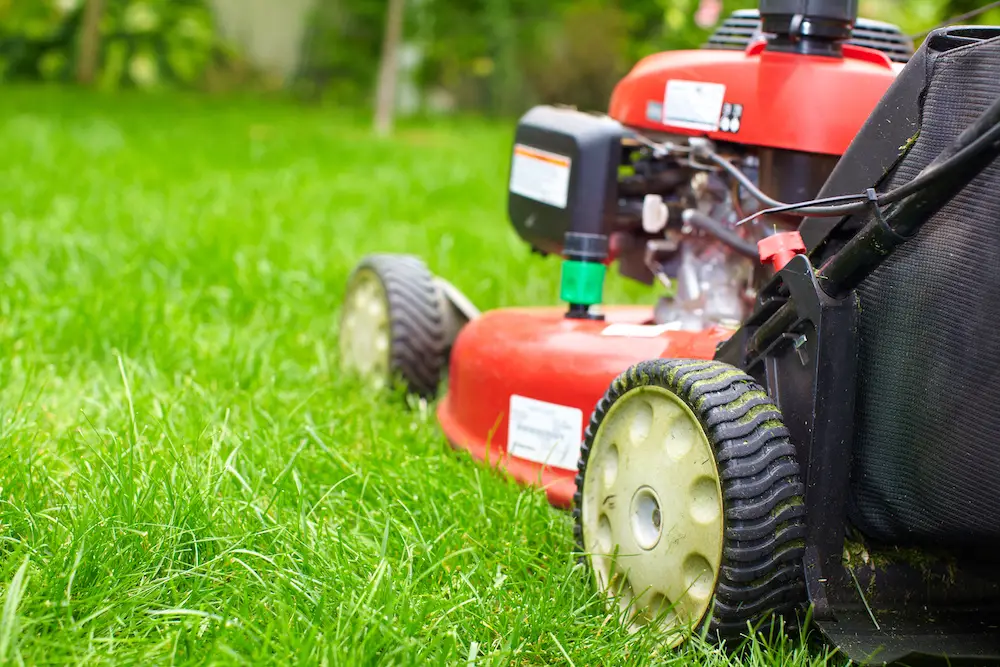Lawn care is such an amazing, therapeutic hobby. However, there are lots of tasks involved to make sure your turf grows beautiful and healthy all year long.
During the winter, grass grows slowly, so most people tuck their lawn mowers away. Once spring arrives, the real work begins.
You might be wondering, when is the best time to mow lawn after winter? Keep reading to find out.
Best Time To Mow Lawn After Winter
Winter is the most “silent” time of the year for gardening. Since winter plants require little to no maintenance and the frigid weather conditions mean there’s not much to do in the yard, most people simply don’t want to venture outside and cut grass.
However, as the temperature starts to warm up in time for spring, it’s time to get your lawn mower and shearer ready.
Whether you’re a lawn care expert or you simply want to keep your garden looking neat, it’s essential to know the best time to mow lawn after winter. That’s because cutting grass too early or too late can damage your turf.
So, when should you begin mowing your lawn? There’s no exact answer to this.
With the ongoing global warming crisis, it can be challenging to determine when the temperature starts to get warmer. Still, there are telltale signs you should watch out for:
Temperature
If the temperature is around five degrees or more for a good couple of weeks, it is safe to start cutting the grass. It’s important to remember that the best time to mow lawn after winter depends on the country you’re in.
For example, if you live in a region with very defined seasons, you can wait for the temperature to be at least five degrees Celcius. On the other hand, if you live in a place where it’s always sunny and there’s little change in weather and temperature, you will likely follow a consistent mowing schedule to keep your lawn in top shape.
Nevertheless, even though the difference in climate varies by country, the first two weeks of April are said to be the best time to mow the lawn for the first grass cut of the year.
Weather Conditions
Another essential factor to consider before you mow your lawn after winter is the weather condition. For example, if there’s still snow on the ground or it is forecasted to snow, you should hold off your plans to cut grass.
If it’s forecasted to rain, you should also avoid mowing the lawn, as cutting grass is best done in dry conditions.
Make sure the ground isn’t frozen or wet. If a frost is due within 24 hours of cutting, you could damage your soil.
Grass Health
Cutting grass at the right time is important to maintain the health of your turf.
Aim for a low cut in the fall just before winter to prepare your lawn as the colder seasons set in. It is equally important not to mow the lawn too early because the hostile conditions of the winter months could damage the grass and make it difficult for them to thrive.
At the same time, if you wait for the conditions to warm up a bit, the grass won’t have to battle hostile weather conditions. Thus, they are likely to grow healthy, resulting in a luscious lawn all year round.

Tips for the First Grass Cut After Winter
Knowing the best time to mow your lawn is just among the many lawn care techniques you should consider.
Before you cut grass after winter, you must do several preparatory steps to ensure vibrant green grass regardless of the season.
Prep Your Lawn
During the last weeks of winter, protect your grass snow piles and foot traffic.
Grass, especially new growth, can be easily damaged by feet or piled snow pressure. Also, stepping on frozen grass can break the blades.
Thus, keep your driveway, sidewalks, and paths clear of snow and debris so that people have a safe place to walk.
Sharpen Your Mower’s Blades
Since you likely haven’t used it for months, your lawn mower may need some fine-tuning before you use it.
The first step to ensuring a beautiful lawn throughout the spring and summer seasons is sharpening your lawn mower’s blades. Even though you will be able to trim the grass with a dull blade, it will not have the same uniformity as you would get from using a mower with sharp blades.
Also, take note that clean-cut grass will recover stress more quickly.
A dull blade can cause tearing of the plant tissue, making the grass more susceptible to damage. Consequently, it can cause your lawn to appear raggedy.
Before mowing your lawn, take a look at the tips of your grass to determine if it’s time to sharpen. You can test a small portion of your lawn.
It may even pull up portions of the grass instead of cleanly slicing through the blades of the grass. Lawn care experts recommend sharpening your lawn mower blade two to four times a year or after about eight mowings.
Know the Correct Cutting Height
It’s important to cut grass at a shorter length before winter, so it doesn’t grow too long during the colder season.
Also, note that the cold temperature delays grass growth; thus, it’s less likely that you will see a big difference from your last cut of fall to your first cut after winter.
Additionally, a correct height for each grass type dictates if it’s ready to be cut. For example, you should cut Bermuda grass once they reach 1.5 to two inches. Meanwhile, you shouldn’t cut fescue grass until it’s 3.75 to 4.5 long.
Don’t Mow All of Your Lawn
After a long period of staying away from gardening activities, it might be tempting to tidy up your entire lawn. However, sparing some parts and letting them stay a little messy is better for wildlife and encourages flourishing habitats.
You can choose the part you’d like to be neat and leave the rest unkempt. The long grass will provide food for butterflies and shelter for other animals.
Consider mowing a pathway leading through the wildflowers. Aside from helping wildlife, keeping a rich garden ecosystem can keep pests at bay.
Clean Before You Mow
After being starved of sunshine for several months, your lawn may look a little neglected.
Before your start mowing, take time to clear dirt and debris that has piled up during the winter months, such as dead sticks, leaves, and rubbish. Check to see what else could be hiding in your gardens, such as stones and thick branches.
If the lawn mower catches any of these, the blade could be damaged. As mentioned earlier, a dull blade could be detrimental to the grass.
Also, check the area for animals that may have made it their home during the winter. Hedgehogs usually live in piles of grass and dirt.
If you find a habitat, consider letting it be and mowing other parts of the lawn instead.
Stick to the One-third Rule
When mowing the lawn for the first time, only cut one-third of the grass blade. Cutting more than this can stress the grass.
Instead, gradually reduce the length of the grass over several weeks until you reach your desired cut height.
Cutting the grass too short and too fast can lead to disease and weed infestation. Yes, this could mean mowing more often than you would like, but it’s the best way to keep your lawn healthy. Allow 10 to 14 days before your next cut.
Don’t Water the Grass Right After Mowing
Generally, you should water your lawn only when it needs moisture. It’s best to avoid watering your lawn after mowing as it can cause damage to the grass.
Avoid watering in the middle of the day when the sun is at its peak. Doing so can lead to water drying up instantly, and the droplets act as a magnifying glass that could burn the blades of the grass.
Meanwhile, watering late in the evening or at night prevent the water from getting absorbed fully by the soil, spurring fungal diseases. The best time to water your lawn is first thing in the morning when the air is still cool and the water can reach the roots of the grass before evaporating.
Always Consider the Temperature and Weather
The best time to mow your lawn after winter is when the temperatures have started to go up, and your lawn has gotten dry and free from snow and moisture.
Don’t forget to tune in to the local news for any weather forecasts. If it’s going to rain or snow in the next few days, postpone your plan to mow until the weather has gotten better.
Before you mow your lawn, make sure your mower has blades sharp enough to achieve a clean cut of grass. To avoid damaging your lawn, you may need to cut grass in increments until you have achieved your preferred length.
Be sure to keep in mind the tips and suggestions above to keep your turf beautiful and vibrant whatever the season.


